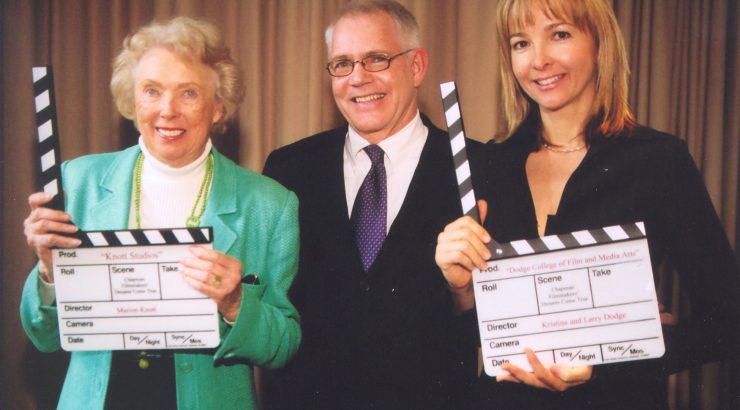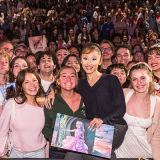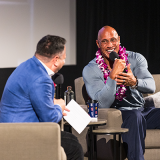Producing a Film School – Part 1
February 27, 2017
Bob Bassett, founding Dean of Dodge College of Film and Media Arts, has often said that building a film school is like producing a film. It requires vision, leadership, a coherent narrative, careful pre-production and production, fund-raising and marketing.
Or, as journalist Terence Loose once wrote in an interview with Bassett in Coast Magazine, “Creating a first-class film school is not unlike making a movie. You start with nothing but a vision and a strong passion, recruit talent and deploy them in their fight against the inevitable setbacks and challenges of any grand undertaking, and finally, hopefully, a blockbuster product flickers to life. And of course there’s the money. You’ll need a lot of it.”
Thirty-five years after Bassett was hired as the first full-time film professor at Chapman, the film school is celebrating the 20th anniversary of the creation of the School of Film and Television, later named Dodge College in honor of the transforming gift of Larry and Kristina Dodge, and the 10th anniversary of its move into Marion Knott Studios, a distinctive facility that has captured and continues to capture the imagination of prospective students and Hollywood visitors alike.
But in the beginning, things were very different. Bassett arrived to find no real film major, just a few film classes in what was then the Department of Communications, a handful of students, and just a couple of pieces of equipment. “The entire film school was in my office,” he says. “I had one lighting kit, one camera and one sound package, which I personally checked out to the kids.”
But it was enough, as Bassett soon realized that teaching film language could only be truly meaningful if students made films—if they learned how camera placement, editing choices, lighting etc. helped shape the stories they wanted to tell.
In what became the basis for the school’s continuing focus on hands-on learning, Bassett took a group of students to Death Valley over Chapman’s Interterm in 1983 for a ”location filmmaking” experience. That, he says, “was the genesis of the film school today—it moved things forward and started everyone thinking larger.”
Thinking larger over the years has involved two key components—more and better. More meant more of everything: more people, more equipment, more space, more reach. And better impacted each of those elements as well.
Driving things forward also meant moving into unknown territory, an often scary direction in the tradition-bound world of academia. Building on a big idea also meant taking risks, risks that required that Bassett clearly articulate his vision to people who could make a difference and get them on board.
One relationship that was central to Bassett’s own development was his friendship with Chapman trustee Marion Knott that blossomed in the early 80s. Desperate for equipment to keep the fledgling program moving forward, conversations with Knott led to a $25,000 gift that went to buy four badly needed cameras.
Knott’s gift was also a turning point for Bassett, when he realized that he could cultivate support from people who understood what he was trying to build. He began studying, reading about, and attending workshops on leadership and fund-raising. That got him over the hump that intimidates many faculty.
“I realized that fund-raising was not about asking for money,” he says. “It’s an exchange of value. Donors find value in supporting projects that are aligned with what they believe is important in the world. Their gifts bring value to the students and the university by enabling young people to pursue their passions and prepare for their careers.”
It was the start of a fund-raising campaign that ultimately raised $50-million and built and equipped Marion Knott Studios, the 76,000-square-foot facility that is the embodiment of one of Bassett’s other radical ideas—to build a mini-studio on campus, where the filmmaking process would mirror real-world production.
Big leaps forward:
Location Filmmaking: Given the need for extended periods of time and the often location-based work needed to make a film, Bassett’s decision to take students to Death Valley set the stage for many years of location-based projects during Chapman’s Interterm session.
As one who had camped and hiked most of his life, Bassett was familiar with the exotic visual landscapes offered by Death Valley and thought it was a good location for a January trip “because it was warm.” So the students packed up tents, food and film equipment, which included film stock bought through Army surplus and headed out for a seven-day shoot of a script written just days before. The resulting post-apocalyptic film, The Cocktail Party, provided an unforgettable experience and was the first of many such trips.
The next year took the students to Cabo San Lucas, an adventure which saw them changing from an air-conditioned Greyhound bus at the Mexican border to a bullet-riddled bus with no heat that tortured them through the frigid mountain pass on the way to the beautiful locale where they finally shot their film. And from there, well, the rest is history….
The devil is in the vision: The switch to non-linear editing was a sea change in the film business. The new process was widely greeted with skepticism at first, both in the industry and in education where editors lamented the lack of a practical/aesthetic component to computer editing (“you can touch or smell the film” was a common complaint). But timing and a willingness to change drove Chapman forward. That, and the sheer practicality of cost. At the time, Chapman had one flatbed editing system, worth about $10,000, whereas schools like NYU had 50 much more expensive Steenbecks (at a cost of about $50,000 each). AVID has just come out with a MAC-only hardware/software package that ran about $150,000.
Bassett saw an opportunity when he learned about DVision, a low-cost PC-based software. With minimal hardware requirements, converting to the new system was within reach. Bassett signed a partnership with DVision in 1994 and built the first editing system himself.
“We were able to switch quickly at a time when a school like NYU, with its huge capital investment and larger size would have faced a much bigger challenge in making that leap. We were small, young, and nimble which enabled us to move quickly,” he says. That, and a belief that a change was coming put Chapman out front, even as some industry editors dug in their heels and students struggled at first to learn the new system, which they nicknamed “devil vision.”
Filmmaker-in-Residence programs: As close to the heart of the industry as Orange County is, in the early days, few in Hollywood had ever heard of Chapman or its film school. Bassett came up with the idea of bringing working filmmakers to campus one day a week for an entire semester and took the idea to Knott who funded it with a million-dollar endowment. That program opened a new avenue into the industry. The arrival of former Academy President and director Arthur Hiller (Love Story, The Out-of-Towners, The Hospital) as Filmmaker-in-Residence in 1999, launched a program that has brought many of Hollywood’s top names to campus over the years—names such as director William Friedkin (The French Connection, The Exorcist). And in the process, they learned what Chapman had to offer, brought others in the industry with whom they’d worked to campus, helping to make Chapman’s film school well known in the industry. Not only did students have the chance to learn from some of the film industry’s best and brightest, but writers, directors and producers came away impressed with the passion and talent of Chapman students.
An incredible added bonus has been that four of those industry veterans who got to know Chapman through the Filmmaker-in-Residence program feel in love with teaching and joined the faculty full-time. Academy Award-winning writer David Ward (The Sting), director John Badham (Saturday Night Fever), director Martha Coolidge (Real Genius) and animator Bill Kroyer (Tron) now share industry wisdom in the classroom while continuing to stay active in the business.
Building a mini-studio: The idea behind Marion Knott Studios was, simply, to teach filmmaking in a working studio—to create a facility unique in higher education with industry standard tools and coherent working spaces. When the University purchased 10 acres of the former Anaconda Wire Company just two blocks from the main campus, location met opportunity and Bassett’s relentless drive to share his vision with Orange County donors. Today, when Hollywood visitors see the production facilities that students get to use, they often say “this is better than what we have in the industry.”
Check back next week for Part 2 of this fascinating article!
EDITOR’S NOTE: This article originally appeared in the Fall 2016 issue of In Production. Read other great articles, and catch up on older issues, by clicking here.


